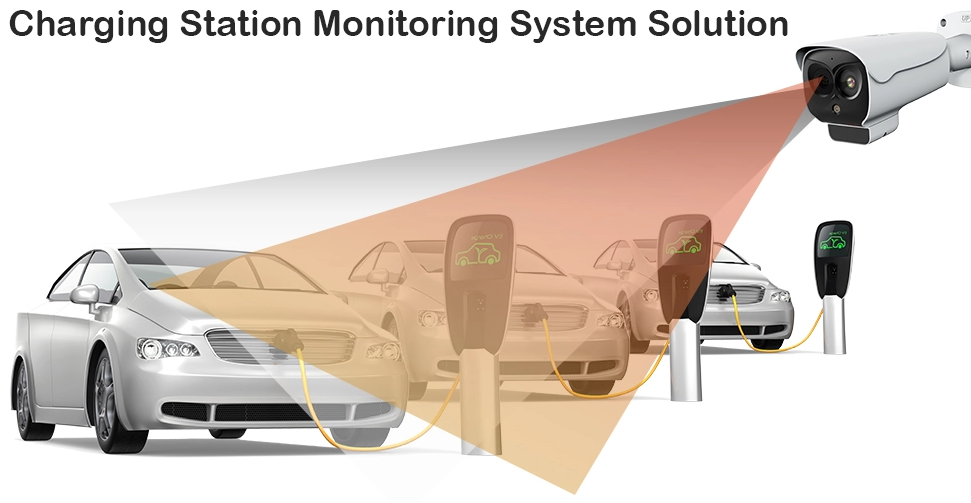As the adoption of electric vehicles (EVs) continues to rise, the need for secure and reliable charging stations becomes paramount. Implementing a robust surveillance system is essential to ensure the safety of both the equipment and users. This article outlines best practices for establishing effective camera and monitoring systems for EV chargers, emphasizing comprehensive coverage, integration with other systems, and compliance with regulations.
1. How to Choose the Right Camera and Surveillance System
Selecting the appropriate camera involves assessing several factors:
• Resolution: Higher resolution cameras provide clearer images for identifying details such as license plates.
• Field of View: Cameras with a wide field of view can cover more area, reducing the number needed.
• Night Vision: Ensure cameras have infrared capabilities for low-light conditions.
• Durability: Cameras should be weatherproof and vandal-resistant, suitable for outdoor use.
• Connectivity: Choose cameras that support Wi-Fi or wired connections for reliable data transmission.
2. How to Make Sure the Charging Area is Covered by Enough Cameras
To achieve comprehensive coverage:
• Conduct a Site Assessment: Analyze the layout of the charging station to identify blind spots.
• Strategically Position Cameras: Install cameras at key points such as entry and exit points, and around charging units.
• Use Overlapping Coverage: Ensure camera views overlap slightly to eliminate blind spots and enhance monitoring.
3. How to Connect the Cameras to the Central Monitoring Station
Effective connection involves:
• Choosing the Right Network: Use a stable network, either wired or wireless, ensuring high bandwidth for video streaming.
• Utilizing PoE Technology: Power over Ethernet (PoE) allows both power and data to be transmitted over a single cable, simplifying installation.
• Integrating with a Central Management System: Use software that allows real-time monitoring, video playback, and alert settings.
4. How to Use Analytics to Detect Suspicious Activity
Implementing analytics can enhance security:
• Motion Detection: Set up cameras to alert when movement is detected in restricted areas.
• Facial Recognition: Advanced systems can identify individuals and track their movements.
• License Plate Recognition: This technology can automatically log vehicles entering and exiting the charging station.
5. How to Set Up Alerts for Unauthorized Access or Vandalism
Establishing an alert system includes:
• Defining Trigger Events: Set parameters for what constitutes unauthorized access (e.g., after hours).
• Real-Time Notifications: Configure alerts to be sent to staff or security personnel via SMS or email.
• Automated Response: Consider integrating alarms or lighting that activate upon detection of suspicious activity.
6. Integrate Surveillance Systems with Payment Platforms
Integration ensures seamless operations:
• Linking Systems: Connect surveillance feeds with payment processing to monitor transactions and ensure security.
• Real-Time Transaction Monitoring: Use video footage to verify payment disputes or incidents occurring during a transaction.
7. How to Do Deterrent Measures Such as Warning Signs
Deterrent measures can discourage criminal activity:
• Visible Surveillance Signs: Post signs indicating the presence of surveillance to alert potential wrongdoers.
• Lighting: Ensure the charging area is well-lit, making it less appealing for vandalism.
8. Setting Up Regular Testing and Updating of the Monitoring System
Routine maintenance is vital:
• Conduct Regular Inspections: Test cameras and system functionality periodically.
• Update Software: Keep all systems and software up to date to protect against vulnerabilities.
9. How to Comply with Relevant Privacy and Security Regulations
Compliance is critical to avoid legal issues:
• Understand Local Regulations: Familiarize yourself with laws regarding surveillance, data storage, and privacy.
• Implement Data Protection Policies: Ensure that any recorded footage is securely stored and accessible only to authorized personnel.
Conclusion
Implementing a comprehensive camera and monitoring system at EV charging stations is crucial for safety and security. By following these guidelines, operators can ensure that their facilities are well-protected, which in turn enhances user trust and promotes wider EV adoption.
Advantages of LINKPOWER
LINKPOWER offers a variety of innovative solutions tailored for EV charging infrastructure. With advanced surveillance options, seamless integration capabilities, and a commitment to compliance, LINKPOWER ensures that charging stations are not only secure but also efficient. Their expertise in managing and monitoring systems contributes to safer environments for both operators and users, ultimately supporting the growing EV market.
Post time: Oct-29-2024


